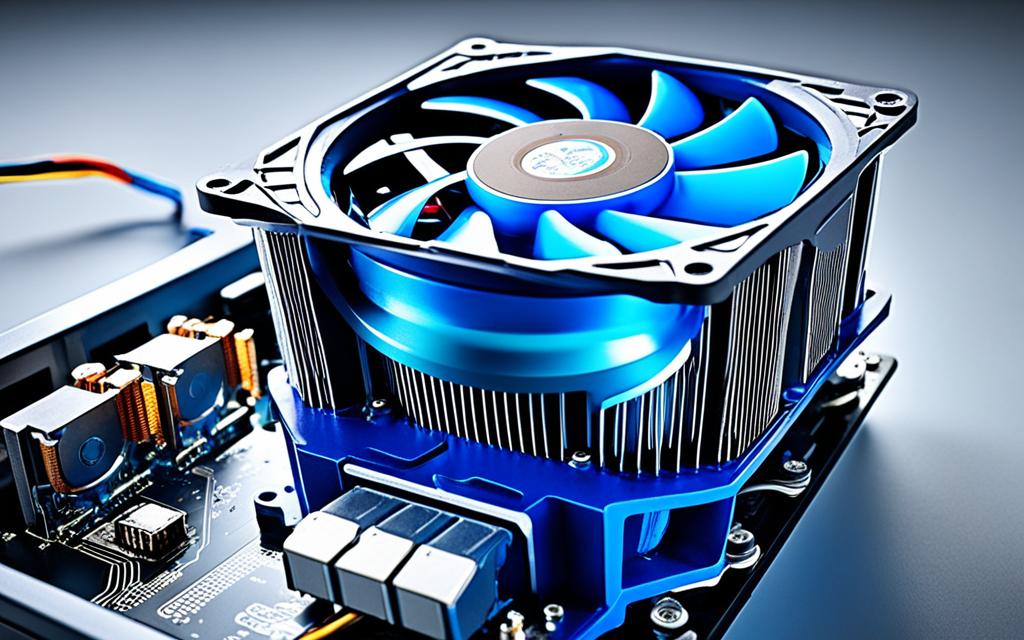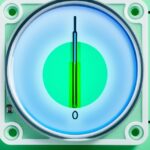Table of Contents
Choosing the right orientation for your CPU fan is key to keeping your computer cool. This orientation ensures better air flow and helps the system perform better. Every fan, whether it’s bringing air in or pushing it out, has a crucial part to play.
With the fans positioned correctly, your computer’s operating temperature will drop. This makes your hardware last longer. By focusing on how to place these fans, you create a more effective and durable computer for any task. runway of a technical use of words and facilitates practical understanding.
Key Takeaways
- Understanding CPU fan orientation is crucial for optimal cooling.
- Proper airflow configuration helps manage system temperatures effectively.
- Distinguising between intake and exhaust fans is key to enhancing cooling performance.
- Regular maintenance, including dusting fans every three to six months, is important for sustaining airflow efficiency1.
- Correct placement of fans can improve overall system performance and component longevity.
The Importance of Fan Orientation
Knowing how to orient fans is key for keeping systems cool. The airflow dynamics inside a computer’s case are crucial for pushing out heat and pulling in fresh air. If fans are placed wrongly, the system’s ability to cool down worsens. This might lead to overheated parts and a drop in cooling efficiency. Since fans have a set direction, where they are put changes the air’s path inside the case.
Understanding Airflow Dynamics
Each fan has a cubic feet per minute (CFM) score that shows how much air it can move. A higher CFM means it can move more air, which is vital for good airflow2. By smartly arranging several fans, you can get better total CFM and airflow. This helps keep things cool2. It’s also important to think about how loud these fans are. Choosing fewer, quieter fans can reduce noise but still cool effectively3.
Effects of Incorrect Fan Positioning
Wrong fan setup can mess up airflow. This might create spots where hot air stays, making cooling less efficient. The best setup has front fans pulling in air and back fans pushing it out. This ensures the air moves smoothly2. Also, using top vents as exhaust helps get rid of hot air that goes up. This is vital to keep parts cool2. Keeping things clean, like the filters, is important too. Dust can really block cooling efficiency2.
| Fan Positioning | Purpose |
|---|---|
| Front Fans | Intake cool air |
| Rear Fans | Exhaust hot air |
| Top Vent Fans | Expel warm air |
| Side-mounted Fans | Intake, may require filters |
Identifying the Correct Fan Direction
Determining the right way to position CPU fans is key for cooling and system performance. Knowing about fan direction indicators from manufacturers is vital for good airflow. These can be arrows on the fan case that show air movement direction. Also, making sense of fan blade design helps if indicators are not clear.
Using Manufacturer Indicators
Fans often come with manufacturer guidance. This guidance might have arrows or symbols showing which way air should flow. Following these signs helps keep the system from getting too hot. It’s important to regularly check these signs to avoid mistakes, ensuring correct airflow indication.
Examining Fan Blade Design
Looking at the fan blade design can tell us a lot about its purpose. If blades lean away from the case, the fan likely pulls in cool air. If they lean towards the case, it’s pushing hot air out. Spotting these details improves setup and system performance.
Common Indicators to Assess Direction
There are a few ways to figure out which way a fan blows. A quick test is to hold a tissue near the fan to check airflow direction. Place intake fans at the bottom or front and exhaust fans at the top or back for best results. This setup keeps airflow balanced and each fan working well. Getting the alignment right is very important. It helps your components last longer and prevents system crashes41
Which Way Should CPU Fan Face
It’s crucial to know the right CPU fan facing direction for efficient cooling. The setup of intake fans and exhaust fans affects airflow inside the case. Intake fans at the front pull in cool air. Exhaust fans at the back get rid of warm air. This setup ensures air moves effectively through heatsinks. It boosting cooling from the CPU to other internal parts5.
Intake vs. Exhaust Configuration
When setting up fans, knowing the difference between intake and exhaust matters. Use intake fans to draw air in towards the components. Exhaust fans should push hot air out. If not managed well, the system can overheat due to poor airflow6. Sometimes, repositioning the CPU cooler can improve cooling for parts like VRMs and memory7.
Optimal Placement Scenarios
In certain cases, the cooler’s height and type affect optimal fan placement. Generally, stock CPU coolers work best when facing up. This helps with removing heat5. But, tower coolers with multiple fans might need different setups. Making sure all fans spin the same way is key for good cooling5.
| Fan Configuration Type | Recommended Orientation | Effectiveness |
|---|---|---|
| Stock CPU Cooler | Upward | High |
| Third-Party Tower Coolers | Depends on configuration | Variable |
| Intake Fans | Front | Optimal |
| Exhaust Fans | Rear | Optimal |
Reviewing these scenarios helps users customise their cooling for the best performance.
For precise advice, look at the manufacturer’s documentation. It gives details on the right fan orientations.
Understanding these cooling principles keeps your system cool. This maximises component lifespan and efficiency.
“Correct fan orientation not only prevents overheating but also extends CPU component lifespan.”
Creating an Effective Airflow Configuration
Building an optimal airflow configuration is key for a PC’s performance and longevity. It’s important to understand positive and negative pressure setups. Each has benefits affecting your system’s temperature and dust levels.
Positive Pressure vs. Negative Pressure Setups
A positive pressure setup features more intake than exhaust fans. It improves airflow into the case and reduces dust entry. This is great for keeping parts clean and working well. Meanwhile, a negative pressure setup has more exhaust fans, helpful for cooling high-performance parts that heat up a lot.
Balancing Intake and Exhaust Fans
Finding the right fan balance is crucial for good airflow. The right setup leads to better pressure control, suiting your cooling needs. Regularly cleaning air filters also helps keep airflow strong, ensuring optimal cooling for important parts like the CPU and GPU.
The best setup often includes intake fans at the front and bottom, with exhaust fans at the rear and top. This layout uses natural convection to enhance cooling. Check out this guide for more on fan placement.
| Setup Type | Advantages | Considerations |
|---|---|---|
| Positive Pressure | Minimises dust, enhances cooling efficiency | Requires extra intake fans |
| Negative Pressure | Improves heat expulsion, can cool hotter components | Risk of dust accumulation, may require dusting |
Keeping the right fan balance ensures optimal airflow management. This leads to cooler case temperatures and better performance. As a result, you get a tougher system overall8910.
Conclusion
Knowing how to place your CPU fan right is key to keeping your computer cool. Placing the fan correctly can help with air flow. This means better performance and a longer life for your PC parts. Most times, you should point the CPU fan to the case’s back. This helps push hot air out. Meanwhile, intake fans should be at the front, pulling in fresh air1112.
Getting the balance right between intake and exhaust fans is important6. It stops your computer from getting too hot and works better. This article gives you the tips to set up your fans, whether they face up or down1112.
Good cooling comes from paying attention to fan position and where they’re placed. By making smart choices, you can build a computer that works well and smoothly. If you need more help on keeping your PC cool, click here for more info.
FAQ
Why is CPU fan orientation important for cooling efficiency?
The right CPU fan placement greatly aids in cooling. It ensures the airflow is optimal, keeping temperatures ideal for operation.
How can I determine the correct orientation of my CPU fans?
Fans often have arrows indicating airflow direction. If you’re unsure, the way the blades curve can also tell you; blades that curve away are for intake, and those that curve towards are for exhaust.
What are the differences between intake and exhaust fans?
Intake fans pull cool air in, usually from the front. Exhaust fans, located at the back or top, push warm air out. It’s key to know this to boost cooling performance.
What are the benefits of maintaining a positive pressure setup?
Positive pressure uses more intake fans to bring in cool air. It lessens dust build-up, making cooling more efficient.
Can a negative pressure setup be advantageous?
Indeed, negative pressure setups push air out effectively. They can be beneficial, depending on your system’s layout, for top thermal performance.
How does fan orientation affect the lifespan of computer components?
Correct fan orientation keeps temperatures low. This is crucial for the longevity of important parts like the CPU and GPU.
What should I consider when setting up my fans for the first time?
Start with pinpointing the best spots for fans. Recognise intake and exhaust differences and ensure fans are correctly oriented to maximise airflow and cooling.
Source Links
- https://www.electronicshub.org/pc-fan-airflow-direction/ – PC Fan Direction (PC Fan Airflow Direction)
- https://www.neweggbusiness.com/smartbuyer/over-easy/pc-cooling-how-to-set-up-computer-case-fans/ – PC Cooling: How to Set up Computer Case Fans – HardBoiled
- https://www.tomshardware.com/how-to/set-up-pc-case-fans-for-airflow-and-performance – PC Airflow Guide: How to Set Up and Position Your Fans
- https://www.pcworld.com/article/394576/how-to-tell-which-way-your-fan-is-blowing.html – How to tell which way your fan is blowing
- https://www.xda-developers.com/which-way-install-cpu-fan/ – Which way should you install a CPU fan?
- https://medcpus.com/which-way-should-cpu-cooler-fan-face/ – Which Way Should CPU Cooler Fan Face? – medCPU
- https://forum.level1techs.com/t/orientation-of-low-profile-cpu-cooler/167100 – Orientation of low profile CPU cooler?
- https://www.silverstonetek.com/en/tech-talk/wh_airflow – Tech Talk∣SilverStone
- https://www.howtogeek.com/303078/how-to-manage-your-pcs-fans-for-optimal-airflow-and-cooling/ – How to Manage Your PC’s Fans for Optimal Airflow and Cooling
- https://www.linkedin.com/advice/0/what-best-ways-optimize-airflow-your-cpu-cooler-gw3kc – What are the best ways to optimize airflow with your CPU cooler?
- https://ms.codes/en-gb/blogs/computer-hardware/which-way-should-the-cpu-fan-face – Which Way Should The CPU Fan Face
- https://softwareg.com.au/blogs/computer-hardware/should-cpu-fan-face-up-or-down – Should CPU Fan Face Up Or Down












